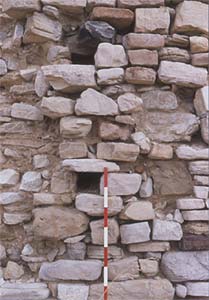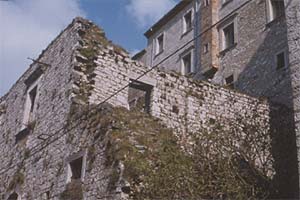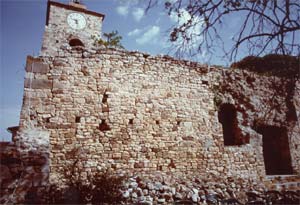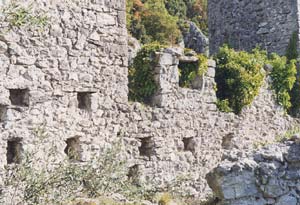 Fortifications
Fortifications
 Military
works : construction techniques
Military
works : construction techniques
One
of the main characteristics of the Molisian fortifications is the adaptation to
the territory on which they rise and the use of local materials: stones (mainly
calcareous but also sandstone) from quarries located not far from the castle
itself, timber (oak and chestnut) from the woods that abound in the region, sand
from the numerous watercourses, bricks and mortar made of local products.
Fortifications erected under pressing conditions in response to an immediate
danger were occasionally built using lower quality materials found directly on
site; sections of castles were often built with used materials taken from
pre-existing monuments. From this point of view Molisian military architecture
bears witness to a building history that shows interesting results despite being
based on construction materials and dressing procedures that were not always of
the highest level. The organisation of the building yard of a castle or Medieval
church undoubtedly required the presence of a few specialised craftsmen (in the
12th century a guild of stonecutters was established in S.Maria di
Guglieto), as well as unskilled labour.
An atlas of the stonemasonry of Molisian castles displays a limited number of
patterns repeated on a large scale with few modifications. Construction
materials often consisted of rough-cut stones, sometimes scabbled, while the use
of finely dressed elements was unusual (for cornerstones, edges and the rare
ornamental elements). A peculiar aspect is the gradual tapering off of walls
towards the top, with corbels used to support floor
cross beams or other structures. The ground floor was often covered with a vaulted
structure of stone, while wooden structures were more frequently used for the
upper floors. The vertical connections were made with wooden stairs or stone
staircases cut into the walls. The main entrance was commonly located on the
first floor for security reasons (the ground floor and basement, which housed
the storerooms and the cistern, could be accessed from the inside) and could be
reached through a removable gangway.
The incorporation of rocky outcrops in the wall structures and the use of wooden
bars to reinforce the masonry represent singular construction solutions. The
greater attention dedicated in recent studies to construction materials and
procedures opens new horizons in our knowledge of the history of fortifications.
The most important are those associated with the period when structures based
mostly on the use of timber (traces of an ancient palisade have been found at
the Tufara castle) were gradually replaced by stone constructions.
|
 |
Palata
Castellerce |
|
 |
Campobasso |
|
 |
Larino |
|
 |
Lupara |
|
 |
Pesche |



![]() Fortifications
Fortifications![]() Military
works : construction techniques
Military
works : construction techniques




